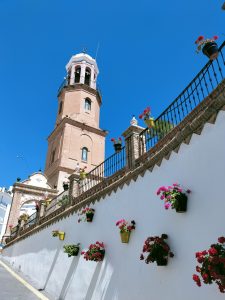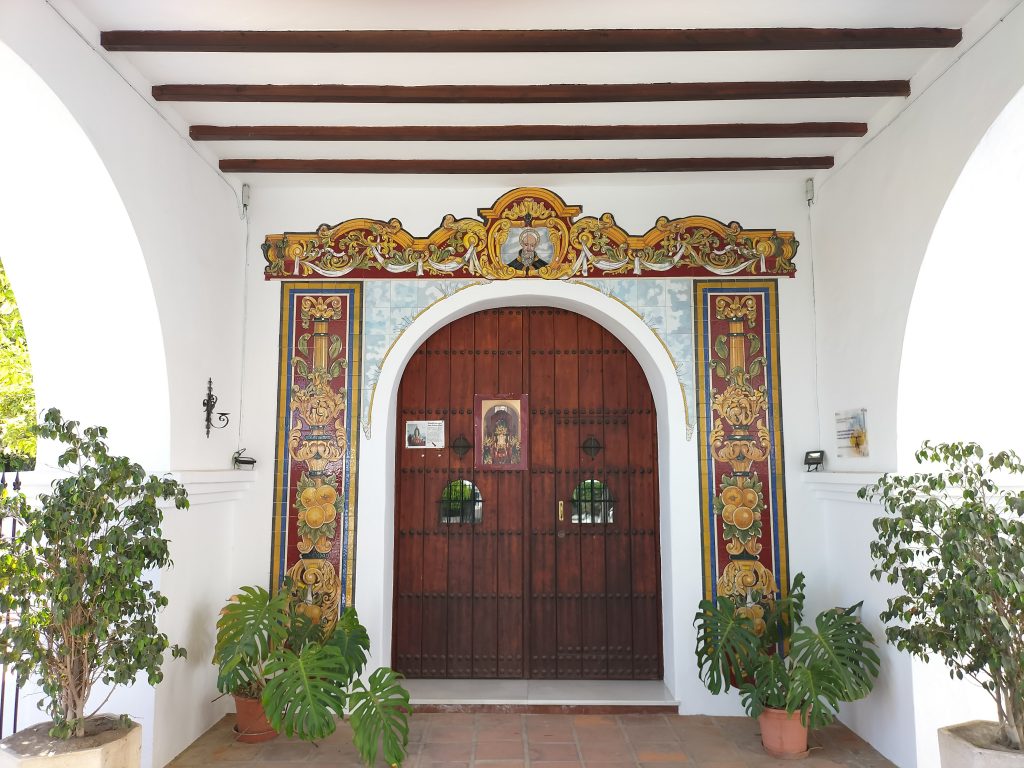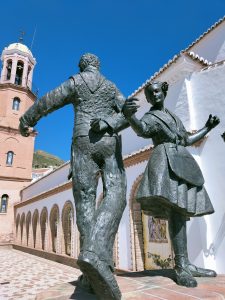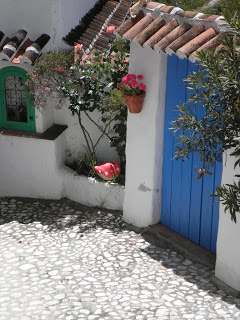La Axarquía, east of Málaga, an area blessed with good soil for wine, fruits and olive oil. From the coast’s fishing villages to the white villages crowning mountain peaks, it’s less than half an hour from the airport yet hundreds of years away. Here, we visit the mountain villages of Cómpeta and Acebuchal.
As we drove up the winding roads, ever higher and higher, I wondered what on earth possessed the Romans to climb these particular hillsides. It’s not easy to navigate nowadays, then it would have been hard work.
What is clear is that Cómpeta has an exceptionally good vantage point for viewing the coastline at Torrox. It is also good for growing grapes and almonds, and the Romans were fond of those.
Cómpeta – growing grapes since the Romans
Cómpeta still has vineyards sprawled across the hillsides, with the raised drying beds looking ever so like giants’ tombs. This is where the grape harvest is laid out in the sun to dry before being turned into the famous sweet Moscatel wine.
In the village you can see the wine press at Plaza de la Vendimia. Enjoy the produce of the wineries in the bars and during the August festival which celebrates the harvest and wine.
 We started in the main square, Plaza de Almijara, where the Nuestra Señora de la Asunción church, built in the sixteenth century stands sentinel. It is known as the ‘Cathedral of Axarquía’ because of its three naves.
We started in the main square, Plaza de Almijara, where the Nuestra Señora de la Asunción church, built in the sixteenth century stands sentinel. It is known as the ‘Cathedral of Axarquía’ because of its three naves.
The village stretches up and tumbles down from the church. Cobbled, narrow streets house everything you need, including enterprising little boys selling second-hand books for €1.
Worth visiting is the Museum of Arts and Traditions, installed in a former nineteenth century barracks. There you can see the utensils used by villagers through the ages as they carried out their rural activities.
At opposite ends of the village are the hermitages of San Anton and San Sebastián. Built in the 18th century, San Antón hermitage is a simple but pretty chapel where village dogs escape the heat of the day under the trees. According to the Madoz dictionary, it was so poor that in 1799 the Royal Subsidy only required it to pay the sum of one maravedî.

San Antón hermitage
The San Sebastián hermitage is also a simple 18th structure though larger, with a single nave covered by a semi-spherical vault.
The night of the wine

Cómpeta celebrates the 15th August with La Noche del Vino (The Night of the Wine). Historically, this is when farm workers would say farewell to their families and leave for the grape harvest. That same night they would sing and dance Cómpeta fandangos in the Plaza de la Almijara square while drinking the fine wine produced in the municipality.
Now the festival begins in the Plaza de la Vendimia square with the traditional treading of local grapes, accompanied by the music of the fandangos of Cómpeta and the verdiales (folk dancing and singing) groups from other localities.
The traditional rural lunch is offered at midday – migas (a fried breadcrumb dish) in huge dishes heated by log fires. This is accompanied with a summer salad made from cod, tomatoes, onions, peppers, olives and, of course, washed down with wine. At night, the fiesta continues in the Plaza de la Almijara.
The lost village of Acebuchal
Acebuchal sits high in the hills of the Sierras Tejeda, Almijara y Alhama between Competa and Frigiliana. It is the Lost Village, a village abandoned for nearly fifty years that quietly returned.
Acebuchal goes back as far as the 16th century, although as its name comes from the Arabic term “acebuche”, meaning olive tree, we can imagine its first inhabitants arrived a lot earlier.
As Franco sought to consolidate his place, he prevented the villagers from staying in their homes at night. He wanted the land clear for his private army to remove any rebels from the mountains. In 1949, Acebuchal was abandoned. In 1998, Antonio ‘el Zumbo’ returned with his wife and family to the home of his ancestors. Acebuchal was found again.
Sunday morning and we were climbing the mountain track from Cómpeta. Fording the clear mountain stream, we rose between the pine trees warming in the early sun.
 Snuggled amongst the trees and alpine flowers the white village is no longer lost or abandoned. After almost 50 years of loneliness Acebuchal started being restored. With holiday lets, resident families and its compact chapel, very few of the buildings remain roofless. White-washed buildings cosy up to the winding cobbled lanes. Splashes of colour from doors, shutters and flowerpots break the monotony of white.
Snuggled amongst the trees and alpine flowers the white village is no longer lost or abandoned. After almost 50 years of loneliness Acebuchal started being restored. With holiday lets, resident families and its compact chapel, very few of the buildings remain roofless. White-washed buildings cosy up to the winding cobbled lanes. Splashes of colour from doors, shutters and flowerpots break the monotony of white.
There are bars, restaurants and places to stay in Acebuchal. So, whether you want to lose yourself for an hour or a week in the serene surroundings, you can.


